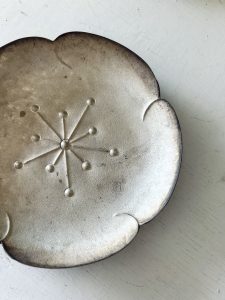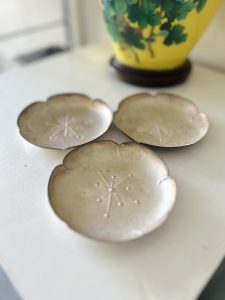お祝いごとを彩ってきた銀製品(愛知県名古屋市千種区姫池通 骨董買取 古美術風光舎)
2024.07.21
皆さまこんにちは。スタッフHでございます。
銀にまつわる色々なお話をさせていただきましたが、本日は銀製品の中でも、お祝いや記念品として贈られることの多い銀杯とボンボニエールについて。

〈銀杯〉
日本では銀杯は伝統的な茶道具や祝い事の贈り物として用いられてきました。銀は魔除けの効果があるといわれ、江戸時代には将軍や大名への贈り物として、また結婚や出産などの慶事において用いられました。
銀杯と聞くと日本では100歳の長寿の祝いに内閣総理大臣から送られるものを思い浮かべる方も多いのではないでしょうか。1963年の老人福祉法制定により9月15日を「敬老の日」に定めて以降、100歳を迎える高齢者には記念としてお祝いの杯を贈る制度が開始されました。当初は木杯でしたが数年後に銀杯に変わり、杯の中央に「寿」の文字と裏面に「内閣総理大臣」の文字が刻まれています。
長年、純銀製のものが贈られていましたが、2016年からは銅、亜鉛、ニッケルの合金に銀メッキしたものに変更されています。
銀杯は古代ギリシャやローマでも儀式やお祝いの場で使用されました。中世ヨーローッパの頃は貴族たちが祝宴の席で使用し、銀杯は地位や権力、栄光の象徴とされてきました。教会では聖杯としてキリスト教の聖体拝領の儀式で用いられ、銀細工職人たちは緻密なデザインを施した銀杯を制作し芸術的な価値を高めていきました。
〈ボンボニエール〉
フランス語の響きが優雅で可愛らしい「ボンボニエール」。もともとはヨーロッパで子供の誕生や結婚式などのお祝い事の際にボンボン(bonbon)と呼ばれる砂糖菓子が配られ、その菓子を入れる容器をボンボニエールと呼びました。その形式が明治時代に皇室に取り入れられ、素材として銀製のものが多いことから「銀のボンボニエール」と呼ばれています。大正時代から昭和時代にかけて流行し、皇室以外でも制作されるようになりました。
日本で初めてボンボニエールが登場するのは明治22年2月11日、大日本帝国憲法発布式にともなう宮中晩餐会だとされています。その後外国からの賓客を招いた宮中晩餐会や、皇室の儀式である、御誕生、御着袴、成年式、立太子、御結婚、御即位、銀婚式などで引き出物として配られました。日本の吉祥文様や皇室の紋章、皇族が個々に持つ「御印」を基にしたデザインなどが施されています。中には金平糖が入っていることが多いようで、手のひらに載るほどの愛らしい菓子器は皇室の御慶事を彩る品とし受け継がれています。
形式は西洋様式ですが、日本のボンボニエールはデザインなど独自の発展を遂げました。
明治時代の廃刀令で刀職人たちが職を失ったことから、職人の生活支援と受け継がれてきた高度な技を維持するという理由で刀職人たちがボンボニエールの製作に携わったようです。兜や和船形などの日本の伝統的なものを模したデザインのボンボニエールも数多く作られ、金属工芸品として外国で称賛され、日本の伝統文化を伝える媒体としての役割も果たしました。
銀製品は食器やカトラリー、ジュエリー、茶道具、酒器、仏具など様々ありますが、美術品や骨董品としての価値により銀そのものの値段よりも査定額が高くなる場合もあります。銀の純度や重さの他にも保存状態や制作者の名声、デザインの希少性などが付加価値となることもあり、作品が入っていた箱や証明書がある場合も査定額が上がる要因となります。
ご自宅に眠っている銀製品など、価値が分かりにくいお品がございましたらご相談ください。
それでは、また次の機会に。

Hello everyone. This is Staff H.
Today, I would like to talk about silver cups and bonbonnieres, which are often given as gifts for celebrations and souvenirs.
Silver cups
In Japan, silver cups have been used as traditional tea utensils and gifts for celebratory occasions. Silver is said to ward off evil spirits, and in the Edo period (1603-1867), it was used as a gift for shoguns and feudal lords, and for celebratory occasions such as marriages and births.
In Japan, the word “silver cup” may remind many people of the cup sent by the prime minister to celebrate the 100th birthday of a person who has reached 100 years of age. Initially, the cups were made of wood, but a few years later they were replaced by silver cups with the word “Kotobuki” (longevity) engraved in the center of the cup and the words “Prime Minister” on the reverse side.
For many years, the cup was presented in sterling silver, but since 2016 it has been replaced by a silver plated alloy of copper, zinc, and nickel.
Silver cups were also used in ancient Greece and Rome for ceremonies and celebrations. In medieval Europe, it was used by the nobility at festive banquets, and silver cups were considered a symbol of status, power, and glory. In churches, it was used as a chalice in Christian communion ceremonies, and silversmiths produced silver cups with intricate designs, enhancing their artistic value.
Bonbonnier.
The French word “bonbonniere” has an elegant and lovely sound. Originally, sugar confections called “bonbons” were distributed at celebrations such as births and weddings in Europe, and the containers for these confections were called “bonbonnières. This form was adopted by the imperial family during the Meiji period (1868-1912) and is called a “silver bonbonniere” because it is often made of silver. It became popular from the Taisho period to the Showa period, and was also produced outside the imperial household.
Bonbonnieres first appeared in Japan on February 11, 1889, at the Imperial banquet held in conjunction with the promulgation of the Constitution of the Empire of Japan. After that, bonbonniere were distributed as gifts at court banquets to which foreign guests were invited, and at imperial ceremonies such as births, ceremonial hakama, coming-of-age ceremonies, coronation ceremonies, marriages, coronation ceremonies, and silver wedding ceremonies. They are decorated with Japanese auspicious patterns, the imperial family crest, and designs based on the “goin” seals that each member of the imperial family holds individually. The bowls are often filled with kompeito (kompeito sugar), and these adorable confectionery vessels, which are small enough to fit in the palm of the hand, have been passed down through the generations as items that add color to the Imperial family’s celebrations.
Although the form is Western in style, Japanese bonbonnieres have developed in their own unique way, including design.
Since swordsmiths lost their jobs during the Meiji period (1868-1912) when the Sword Law was abolished, swordsmiths were involved in the production of bonbonnieres in order to support their craftsmen and maintain the advanced skills that had been passed down from generation to generation. Many bonbonnieres were designed to resemble traditional Japanese objects such as helmets and wafune shapes, and were praised in foreign countries as metal crafts, serving as a medium for communicating traditional Japanese culture.
Silver products include tableware, cutlery, jewelry, tea ceremony utensils, sake cups, Buddhist ritual utensils, etc. In some cases, the appraisal value is higher than the price of the silver itself due to its value as art or antique. In addition to the purity and weight of the silver, the condition of preservation, fame of the creator, and rarity of the design may also add value.
Please contact us if you have any silver items at home whose value is difficult to be determined.
See you next time.
*******************
ご実家の整理やお片付けなどをされている方のご相談などが多くございます。
お片付けなどくれぐれもご無理のないようになさってくださいませ。
風光舎では古美術品や骨董品の他にも絵画や宝石、趣味のお品など様々なジャンルのものを買受しております。
お片付けをされていて、こういうものでもいいのかしらと迷われているものでも、どうぞお気軽にご相談下さいませ。
また風光舎は、出張買取も強化しております。ご近所はもちろん、愛知県内、岐阜県、三重県その他の県へも出張いたします。
まずは、お電話お待ちしております。
愛知県名古屋市千種区姫池通
骨董 買取【古美術 風光舎 名古屋店】
TEL052(734)8444
10:00-18:00 OPEN
#出張買取#骨董#古美術#骨董品#絵画#版画#茶道具#刀剣#彫刻

